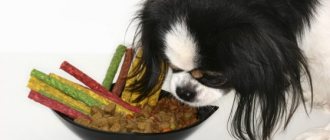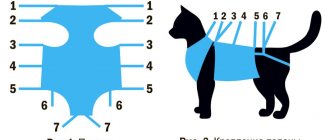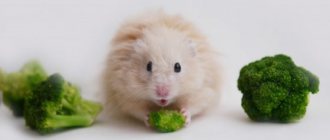Basic Rules
Natural food for dogs is food that excludes dry food. This applies to:
- meat and offal;
- fish;
- dairy products;
- cereals and bran;
- vegetables and fruits.
There is a lot of controversy surrounding the principles of pet nutrition. Some veterinarians are in favor of ready-made food, while others are categorically against it. It’s up to you to decide how to feed your dog, but you need to remember that natural nutrition requires a lot of effort from the owner. After all, for it to be beneficial, the diet must be varied and balanced. Here are some basic rules:
- All components of a multi-component dish are mixed into bowls immediately before serving.
- Any food is given before feeding; if the dog leaves something, then the portion should be reduced.
- The pet must have constant access to clean and fresh water.
- Meat products are offered raw; it is advisable to freeze them beforehand, this will reduce the risk of infection by parasites.
- Meat, fish, dairy dishes do not mix.
- Food is cut into pieces according to the size of the individual; small breeds cannot “handle” large pieces.
- The diet includes cereals (buckwheat, rice, millet, rolled oats), pasta leads to excess weight.
- You can cook cereals in water or broth.
- If you mix meat with vegetables, both products must be in the same form (either raw or cooked), otherwise the rate of digestion will be different.
- Sea fish is served fresh; river fish are best boiled, as there is a high risk of infection with worms.
- The dishes are not seasoned (with the exception of a small amount of salt if the pet refuses bland food).
- Food must be fresh.
- It is prohibited to mix dry food with natural food for dogs; this causes serious disturbances in the gastrointestinal tract and metabolism.
If you decide to switch your pet from dry food to natural food, do it gradually. The optimal transition time is 14 days. During this period, it is better to give the animal probiotics, they will help normalize intestinal function.
Vitamins are also important for dogs with a natural diet. Even in a balanced diet, the owner cannot calculate the amount of useful elements eaten; as a rule, they are not enough, so multivitamin complexes are recommended.
Does dry food need any supplements?
If you look carefully at the packaging of any dry dog food, you will see the mark “complete food” or complete food in English. This means that this finished product is a completely balanced diet of all nutrients, replenishing all the nutritional needs of the animal and not requiring any additions.
The only addition without which feeding dry food is simply impossible is clean, fresh water in unlimited quantities. It should be changed more often, since the dog’s saliva and food debris often get into the water bowl, which leads to the growth of bacteria.
Other additions to dry food can ultimately result in an imbalance of nutrients and cause a deficiency or, on the contrary, an excess of any element in the dog’s body.
Advantages and disadvantages of natural food for dogs
Feeding with natural products has its pros and cons; after weighing them, you will understand how acceptable this method is for you. Benefits include:
- Control of the composition and quality of products, you choose them yourself.
- In the wild, ready-made food is not used, that is, this is the most natural type of nutrition.
- Homemade food does not contain preservatives, flavors and other flavoring additives that are used to increase the shelf life of “drying”.
- Compared to professional food, homemade meals are cheaper (especially for large breed dogs).
- You can vary the menu depending on the needs of your pet (it is easier to choose a diet for allergy sufferers, gastritis and kidney diseases).
Despite so many advantages, there are several major disadvantages:
- Labor intensity. The owner will have to prepare food once every 1-2 days.
- Difficulty maintaining balance. Calculating how many vegetables there should be, how many cereals, how many times a week there should be fish days is not so easy.
- Inconvenience of feeding while traveling or in the absence of owners. More often in this case, the animal is forced to switch to dry food, which causes the stomach to suffer even more.
- For small breed dogs, it is cheaper to use ready-made food, since they eat little, but have quite whimsical tastes.
Individual approach to feeding your dog
Giving an adult dog two meals a day fully meets his natural needs. But owners often encounter requests from their pet to feed it during the break between feedings. Then the question arises whether it is necessary to meet such wishes and requirements of the dog. There are several recommendations from experts that will help you find the right solution:
- It is necessary to determine whether the dog is truly hungry. For example, if a small dog, according to regulations, needs to eat up to 300 grams of dry food per day, but it is highly active and moves a lot, you can increase the volume to 350 g.
- The occurrence of a feeling of hunger before the prescribed meal may be a consequence of poor quality food. Purchasing a ready-made economy product will most likely lead to malnutrition, since it contains too little meat. If the dog eats this food, the amount should be increased by 30-40%. Cooked food may also be insufficiently nutritious if the diet does not include fish, meat, eggs, and offal.
- It should be taken into account that these pets quickly learn to manipulate people. If for every request the dog is given a treat, a piece of sausage, then he will demand food without feeling hungry. This behavior cannot be encouraged; obesity will cause serious health problems.
- You can meet your pet halfway if the requests are too persistent and there are doubts about whether he is hungry. But you need to give your dog not rich food, but an easy replacement in the form of vegetables and low-fat kefir.
- Parasites may be the cause of increased appetite. If your dog is eating well but is underweight, you should contact your veterinarian. A specialist will conduct research and help you choose the best food for your pet.
How to properly feed your dog natural food?
The feeding regimen depends on the age and weight of the dog. It is important not to overfeed the animal or give too large portions. For proper nutrition, it is recommended to follow the following scheme:
| Dog's age | Number of meals |
| 1-4 weeks | 6-8 |
| 2-3 months | 5-6 |
| From six months to a year | 3 |
| Adult dog | 2 |
Sometimes breeders practice one-time feeding; this is not the most optimal option, since the pet eats a large portion at a time. Due to the feeling of hunger, he eats quickly, chews food poorly, and indigestion occurs. You can calculate the rate of feeding your dog natural food based on its weight:
- up to six months it is 6% of the animal’s weight;
- for older pets – 3-4%.
The figure may fluctuate, because there are hyperactive breeds that may require more calories, and there are pets that like to lie down and eat smaller portions.
Percentages are presented per day, that is, if you come up with a figure of 500 grams, you divide it by the number of meals.
The menu for your pet is also compiled in accordance with its basic needs. There is no need to make frequent changes; it is better for the diet to consist of familiar foods. It must contain:
- Meat products – 50-70%.
- Cereals and cereals 15-40%.
- Vegetables 15-25%.
- Up to 1% fat.
Feeding sterilized dogs natural food makes adjustments. Due to the tendency to be overweight, it is necessary to reduce the amount of porridge and increase the percentage of fiber (vegetables, fruits) and protein (meat).
Fish days include 1-2 times a week, it is better to give fatty varieties, they are boiled and cleaned of bones and heads. This food is allowed from 5 months, it is a source of protein.
Fermented milk products are a useful addition; they are given to an adult dog. Milk is offered during puppyhood. Such food will create healthy intestinal microflora.
Let's talk separately about the bones. The dog needs them to clean and grind their teeth. Porous or spongy bones are perfect; it is forbidden to give tubular parts of the chicken skeleton, they can injure the animal.
What can you give?
We said that it must be present in a pet’s diet, however, it can be varied. The permitted components will only bring benefits and saturate the body with the necessary microelements. Helpful supplements include:
- Vegetables and greens. Give everything except legumes, potatoes and white cabbage, they cause bloating.
- Chicken (if there is no allergy) and quail eggs are given raw 1-2 times a week; they are usually added to the main dish.
- Bran, they contain many useful elements, are added to liquid foods, and can be mixed with fermented milk products.
- Unsweetened fruits, berries, dried fruits, crackers, biscuits - in the form of a delicacy.
- Olive, flax, pumpkin, sunflower oils, their quantity depends on the size of the dog, add from a few drops to 1 tbsp. l.
Sometimes you can pamper your animal with store-bought treats, hard cheese, sauerkraut or seaweed.
What should you not give?
There is also a list of foods that are not recommended to be given. They cause gastrointestinal upset:
- confectionery;
- pasta and bakery products (lead to excess weight, difficult to digest);
- onions and garlic have an aggressive effect on the stomach;
- grapes cause fermentation and bloating;
- fatty meats, pork;
- mushrooms are not digestible, there is a risk of poisoning;
- soybeans, corn and semolina are poorly digestible;
- any preserved, spicy and fried food is taboo;
- Tubular and small fish bones carry a greater risk of injury.
Feeding rules
Each category of dog has its own rules and feeding characteristics. They must be followed for a more harmonious development of pets.
Puppies eat from a bowl
Puppies
In the first weeks after birth, puppies suckle from their mother every two hours; by a month, the number of feedings decreases to 5-6 times. If you adopt a puppy at such a young age, he will need to be fed a bitch milk replacer until he reaches 2 months.
But more often than not, babies end up with their new owners on complementary foods, so it’s a good idea to ask the breeder what type of food he used and what kind of food he gave.
In the first week, the puppy's diet should consist only of familiar types of food.
You can change it starting from the second week, carefully and gradually adding new products. In this case, it is necessary to monitor the baby’s appetite and stool.
Feeding table by age:
| Age (months) | Number of feedings |
| 1-2 | 6-7 |
| 2-4 | 5 |
| 4-6 | 4 |
| 6-10 | 3 |
| over 10 | 2 |
The first complementary food is given at 7-8 o'clock in the morning, the last - around 21-22 o'clock. The time of the last feeding directly affects the pet's sleep. The later it is, the more peacefully the puppy sleeps.
When choosing a natural type of nutrition, starting:
- From the 2nd week, a chicken egg is introduced into the diet, which is added to milk or mixture and minced fresh meat.
- From the 3rd - a little white bread or liquid semolina porridge, gradually reducing the daily amount of milk. To prevent rickets - cottage cheese, crushed to a pasty state.
- From 4 weeks of age - meat broth.
- Puréed vegetables are introduced per month.
- At 2 months of age, puppies are completely transferred to regular food.
If industrial feed is chosen as complementary food, you must follow the instructions on the packaging. In the first month they are soaked in a bitch's milk substitute, then in meat broth. You can use wet food from the same manufacturer.
Up to 6 months, puppies are given a daily amount of food that is 7% of their body weight. After six months - 3-4%. The daily volume should be evenly distributed between portions. If your puppy doesn't have enough food, it's hard not to notice. A hungry pet will lick the bowl, collecting every crumb. In this case, the portion can be increased slightly.
Lactating bitch
Pregnant and lactating bitches
During pregnancy, the dog’s body adapts to bear offspring; not only physiological, but also hormonal changes begin to occur in it. It is very important that during this time the expectant mother receives as many nutrients, vitamins and minerals as possible.
Starting from the 2nd month, the number of feedings is increased to 3-4 times a day, gradually adding the serving size. You should not overfeed your dog so that obesity does not lead to complications during pregnancy and childbirth. By the end of pregnancy, the bitch should receive half as much food as before. Just before giving birth, she may refuse to eat, but you need to provide her with enough fresh water.
When feeding with industrial feeds, you should choose those that are marked “For pregnant women.” With a natural type of nutrition, only fresh and high-quality products are taken. The diet must include:
- lean meat;
- offal (cooked for a few minutes);
- sea fish;
- dairy products;
- vegetables, cereals, herbs.
Prohibited foods include legumes, cabbage and potatoes due to their ability to cause bloating and increased gas formation.
A few hours after giving birth, your dog should be given food and fresh water, although she may not have an appetite. In the 1st week, the lactating bitch is fed only liquid food. This can be porridge with meat broth and milk, as well as fermented milk products. Meat, poultry and fish are gradually introduced.
By the 3rd week, she should switch to a nutritious diet, excluding vegetables. To stimulate milk production, walnuts are introduced or apilak is given. From the 6th week, the bitch is prepared for the end of lactation and the transition to a normal diet. To do this, she is not fed or given water for 24 hours.
There are times when, for some reason, a mother dog cannot feed her offspring. In this case, a bitch milk substitute will come to the rescue. It contains a chemical composition close to natural milk, which allows for a complete replacement.
Elderly dogs
As dogs age, their metabolism is disrupted and the risk of obesity develops due to low mobility, so the diet should be adjusted. First, they reduce calorie content by reducing the volume of cereals and adding more vegetables, fermented milk products, and lean meat. The portion size is reduced, increasing the number of feedings up to 3-4 times.
The transition to a new diet should not be abrupt. It is recommended to transfer the dog to it within six months.
Elderly pets very often suffer from constipation, so their diet should contain more fiber, and due to dental problems, food is given pureed. There are also ready-made foods for aging dogs on sale. They contain all the necessary substances to maintain the pet’s body.
Sick dogs
The diet of a sick dog should be adjusted only by a veterinarian and take into account the diagnosis and condition of the pet.
Sample menu
The most convenient way is to create a menu for the week in advance. This way you will have frozen raw materials in advance, from which it is convenient to cook. By the way, you can make natural food on a small budget. Here are some recipes:
- Take beef heart or other offal (kaltyk, trachea, lung). For 1 kg. the main ingredient is 100 grams. dry rice. Boil the broth, then drain half (it can be used later), and add cereal to the other half and cook it. Finely chop the meat, add grated carrots and zucchini, season with a spoon of vegetable oil. The number of servings depends on the size of the dog.
- Cook the broth on the beef bone, it should be rich. Add buckwheat to get the consistency of liquid porridge. Cut the trimmings there, add carrots and fresh herbs.
- Not all pets love vegetables, they are especially important for older dogs, so you can use a trick. Cut carrots, pumpkin or zucchini into small slices, wrap them in cottage cheese, and roll them into a ball. Bake this dessert for 15-20 minutes, your pet will be happy.
Change by-products and grains; variations will provide the maximum amount of substances your dog needs.
Video: feeding a dog natural food, approximate diet and feeding table
Why is obesity dangerous in dogs?
Here are just some of the dangers:
- First of all, obesity is dangerous because it has a negative impact on all internal organs and leads to disruption of their normal functioning. The list of complications caused by obesity in dogs is extremely long: metabolic disorders, decreased immunity, gastrointestinal diseases, heart disease, liver and kidney problems, skin diseases, blindness. The list could take a very long time.
- In addition, excess weight puts severe stress on the spine, limbs and joints. Over time, they simply cannot stand it and deforming arthrosis develops. The dog simply can no longer move independently.
Useful tips
We have given all the necessary information to create the right diet. In conclusion, here are some more useful tips:
- Take raw materials from trusted sellers; farms and meat depots are best suited.
- Always cook or freeze the product.
- Do not overfeed your pet.
- The rules for calculating portions apply to an adult healthy dog; for a working or pregnant dog, the amount of food is increased; for domestic and elderly dogs, it is reduced.
- Never leave food in a bowl; your pet should eat everything until the end.
Natural food is as close as possible to the natural living conditions of animals. If you are willing to put in the time and effort, you can create a balanced, healthy diet that will ensure your pet’s excellent health.
Nutrition of an emaciated animal
A dog's morbid thinness naturally causes concern among owners. It is worth finding out what caused the dog’s significant weight loss. To do this, it is worth visiting a veterinary clinic. Where the doctor will conduct an examination, rule out diseases that affect the weight of the animal. It is usually recommended to complete a full course of treatment against parasites and balance your diet. Perhaps increasing the volume of food fed and the frequency of feedings.
The diet of an emaciated animal must include food rich in proteins and carbohydrates, a variety of fermented milk products, chicken eggs, lean meat, cereals and vegetables. If you come across a starving animal that has not received normal nutrition for a long time, then you need to be attentive to the dog’s health.
Regardless of age, feeding should be more frequent and smaller than for a healthy dog. It is not recommended to feed the dog fresh meat during the recovery stage. It should be deep-frozen or heat-treated to eliminate the presence of parasites. Meat products must be mechanically processed to prevent starving animals from swallowing large pieces.
The dog's body's need for table salt is significantly lower than the human body's. When preparing food for your dog, the dishes should not be salty to your taste. Don’t forget about vegetable oils; they are an extremely tasty and healthy supplement for dogs. Knowing how to feed your dog natural food, following simple rules for creating a diet and feeding schedule, you will get a healthy and cheerful dog. For each dog breed, depending on age and body weight, the individual amount of food required is calculated.
Currently reading:
- Seven Signs and Remedies for Getting Rid of Fleas in Dogs
- 8 ways to treat papillomas on a dog’s body
- Thyroid dysfunction in dogs (hypothyroidism)
- The American Cocker Spaniel is an adroit hunter and loyal friend.










